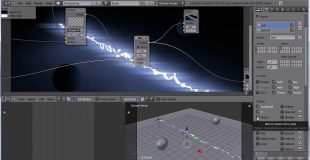https://i.ytimg.com/vi/MBhUT8LSEnM/hqdefault.jpg
A tutorial explaining how to create an electric shock – lighting effect which emits light onto objects and is completely animate-able. Please, don’t forget to like and subscribe for more tutorials and videos.
Blender 2.58 from www.blender.org
source

21 responses to “Blender 3D Electric Shock Tutorial”
Interesting tutorial, subscribed.
Has anyone tried this recently? I couldn't get it to work with 2.78. It just doesn't take the same electric shape.
This will become useful for my Flash effect videos in Blender.
How to include it in Blender game engine?
Cool Cool
thanks for the tutorial it helped me out with a similar project.
p.s. we can hear you breath through your nose better than hearing your voice
Hi, may i ask how to apply the lightning to a model and give the effect as in this website picture i tried allot and searched in websites but cant find hope you can help thanks http://www.digitaltutors.com/tutorial/258-Beginners-Guide-to-Rotoscopes-in-Softimage
and why theres 2 layer in render?
why a lot bugs?
why use track instead parent for the 2 empties?
doesn´t work for me unfortunately :/ blender version 2.68
Thank you very much for this tutorial. I always did lightning with a zero gravity particle system and made it shoot out in a very dense line. Then i would use a turbulence modifier to get the lightning distortion.
Very helpful. Thanks!!
Brillant !
Great video, just need to slow down a little when doing nodes. Was hard to follow and had to watch a few times.
Anyone know how he was able to hide the electricity under part of that spinning object he used in his other video? The electricity has to be on the top layer I would think but at times that spinning object covers the electricity and the glowing layers as well. What would I look into to accomplish that?
The way I fixed it was just adding it from the menu instead of pressing CNTRL-T…
Can you use this technique in your video to create Force Lightning just like in Star Wars?
@NerdyNerdsUnited You don't HAVE to, but it is better to render out as pictures first. If you start rendering as a Quicktime movie, and the render is taking a very long time, if the render crashes, you can't keep all the rendering which has already happened. However, if you render out as images and the render crashes, you can keep the rendered images, then resume from where it crashed.
Once it's all rendered, you can put the image sequence into the video editor and render as Quicktime movie.
QUESTION! Do you have to render the shock out as pictures or can you render it out as a QuickTime Movie? Thanks
Would love if people normalized their audio so when jumping from one video to another soundlevel are fairly the same 😀